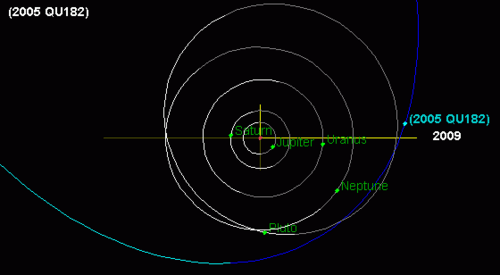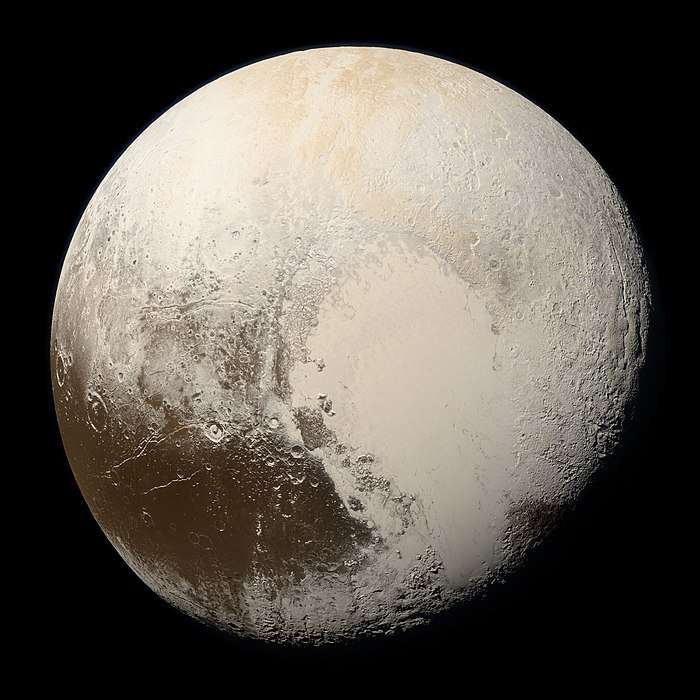(303775) 2005 QU182
(303775) 2005 QU182, also written as (303775) 2005 QU182, is a trans-Neptunian object with a bright absolute magnitude of ca. 3.6.[4] Mike Brown lists it as probably a dwarf planet.[7]
| Discovery[1] | |
|---|---|
| Discovered by | |
| Discovery date | 30 August 2005 |
| Designations | |
| 2005 QU182 | |
| TNO (SDO)[2][3] | |
| Orbital characteristics[4] | |
| Epoch 13 January 2016 (JD 2457400.5) | |
| Uncertainty parameter 2 | |
| Observation arc | 13642 days (37.35 yr) |
| Aphelion | 184.19 AU (27.554 Tm) (Q) |
| Perihelion | 36.827 AU (5.5092 Tm) (q) |
| 110.51 AU (16.532 Tm) (a) | |
| Eccentricity | 0.66675 (e) |
| 1161.74 yr (424325.7 d) | |
| 13.854° (M) | |
| 0° 0m 3.054s / day (n) | |
| Inclination | 14.032° (i) |
| 78.395° (Ω) | |
| 223.69° (ω) | |
| Earth MOID | 35.8244 AU (5.35925 Tm) |
| Jupiter MOID | 31.769 AU (4.7526 Tm) |
| TJupiter | 6.711 |
| Physical characteristics | |
| Dimensions | 416±73 km[5] |
| 9.61 h (0.400 d) | |
Sidereal rotation period | 9.61 hr[4] |
| 0.328+0.160 −0.109[5] | |
| 20.9[6] | |
| 3.80±0.32,[5] 3.6[4] | |
Distance
It came to perihelion in 1971[4] and is currently 51.8 AU from the Sun.[6] In April 2013, it moved beyond 50 AU from the Sun.
It has been observed 81 times over 10 oppositions with precovery images back to 1974.[4]

2005 QU182 takes over 1,200 years to orbit the Sun. Of the known and likely dwarf planets, only Sedna, 2012 VP113, 2013 FS28 and (445473) 2010 VZ98 have a longer orbit around the Sun.[8]
See also
- List of Solar System objects most distant from the Sun in 2015
References
- "MPEC 2007-R03 : 2004 PF115, 2004 PG115, 2004 XA192, 2005 QU182". IAU Minor Planet Center. 1 September 2007. Retrieved 26 August 2009.
- "List Of Centaurs and Scattered-Disk Objects". Minor Planet Center. Retrieved 22 January 2009.
- Marc W. Buie (24 October 2008). "Orbit Fit and Astrometric record for 05QU182". SwRI (Space Science Department). Retrieved 9 December 2008.
- "JPL Small-Body Database Browser: (2005 QU182)" (last observation: 2009-09-18). Retrieved 7 April 2016.
- Santos-Sanz, P.; Lellouch, E.; Fornasier, S.; Kiss, C.; Pal, A.; Müller, T. G.; Vilenius, E.; Stansberry, J.; Mommert, M.; Delsanti, A.; Mueller, M.; Peixinho, N.; Henry, F.; Ortiz, J. L.; Thirouin, A.; Protopapa, S.; Duffard, R.; Szalai, N.; Lim, T.; Ejeta, C.; Hartogh, P.; Harris, A. W.; Rengel, M. (2012). ""TNOs are Cool": A survey of the trans-Neptunian region IV. Size/albedo characterization of 15 scattered disk and detached objects observed with Herschel-PACS". Astronomy & Astrophysics. 541: A92. arXiv:1202.1481. Bibcode:2012A&A...541A..92S. doi:10.1051/0004-6361/201118541.
- "AstDys 2005QU182 Ephemerides". Department of Mathematics, University of Pisa, Italy. Archived from the original on 17 May 2009. Retrieved 16 March 2009.
- Michael E. Brown. "How many dwarf planets are there in the outer solar system? (updates daily)". California Institute of Technology. Archived from the original on 18 October 2011. Retrieved 28 March 2014.
- "JPL Small-Body Database Search Engine: H < 6 (mag) and a > 80 (AU)". JPL Solar System Dynamics. Retrieved 14 June 2014.
External links
This article is issued from Wikipedia. The text is licensed under Creative Commons - Attribution - Sharealike. Additional terms may apply for the media files.
_(cropped).jpg)
